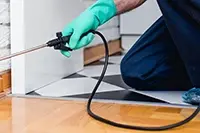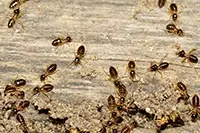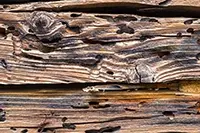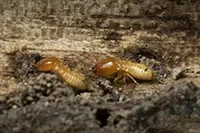Termite Control
Termite Control From Seitz
More than 365,000 homes in the United States are involved in a fire each year. More than 600,000 U.S. homes suffer termite damage totaling over $1.5 billion annually. That is more damage than is caused by all fires, storms, and earthquakes combined. More than 2 million homes require termite treatment each year. Homeowners insurance can help recover losses from fires, storms, and earthquakes, but it is almost impossible to carry insurance against termite infestation. This problem affects many cities in Pennsylvania, including Allentown, Bethlehem, Easton, Scranton, Wilkes-Barre, Stroudsburg, Lancaster, Reading, Trexlertown, Tannersville, and Tamaqua, PA.
Finding out that your home has termites instills a sense of fear among most homeowners. You typically can’t see them, you can’t hear them, and frequently only a trained inspector can find signs of infestation. Treatment by the homeowner for the control of termites is virtually impossible. Specialized equipment is used, and experts have the knowledge necessary to develop control strategies.
Your termite control specialist at Seitz Bros can provide protection from termite infestation. Termites can be found in almost every state, including Mexico and parts of Canada. They feed on wood and may also destroy paper products such as books, cardboard boxes, furniture, and various other items. Even buildings with steel framing and masonry walls are targets because of the wooden door and window frames, wooden support beams (often hidden), cabinets, or shelving within them
How Termites Find Their Way Into Your Home
Subterranean termites build nests in the ground. They search (“forage”) for wood (food) farther and farther from their nest as their colony numbers grow. Foragers may make underground tunnels or above-ground “shelter tubes” of mud, feces, and debris used to search for new food sources and to connect their nests to their food. They can enter a building without direct wood contact with the soil through such tubes. Termites can enter buildings through cracks, expansion joints, foam insulation below ground, hollow bricks or concrete blocks, or through spaces around the plumbing. They can find their way into a structure through an opening as small as 1/32nd of an inch. Any building, whether constructed with a slab, basement, or crawl space foundation, can be infested by termites.
In certain areas of the country, you may encounter different types of termites, such as Formosan, damp-wood, or dry-wood termites. If your home is infested with one of these termites, it may require different or more extensive treatment procedures, including wood treatment or fumigation.
SCHEDULE YOUR SERVICE
Signs of Termites
Several possible signs of a termite infestation, which a homeowner might see include:
- Pencil-sized diameter, or larger, mud tubes running across bare concrete or masonry between the soil and any wooden part of your building.
- Thin, small, papery wings, all the same size, and shape, ⅜-½ in. long, on your window sill, countertop, or floor (especially if it is late Spring and there has been a recent rain)
- Thin, “bubbled,” or distorted areas of paint on wooden surfaces, especially if these feel cool to the touch.
- Any wooden building parts (especially if they are important to support structures) begin to “sag” unexpectedly.
Preventative Measures You Can Take
There are several things you can do as a homeowner to help prevent or avoid termite infestations, including:
- Stack all firewood, lumber, or other wooden items several feet away from your building.
- Keep all wood supports of porches, patios, decks, or separate buildings more than one foot from contact with your home’s foundation, and use only pressure-treated wood for all construction that contacts the ground. Even treated wood has a limited protection period.
- Move all wood-containing mulch (even cedar or redwood) and decorative wood chips at least one foot away from your foundations. Sand and stones can be just as attractive, and they discourage pests (including termites) from harboring next to your building.
- Repair any leaking water lines or fixtures, especially any that wet any wooden part(s) of your house. Repair any eaves, down-spouts, gables, or shingles that allow wooden parts of your house to get wet, even occasionally.
- Monitor moisture levels and take steps to reduce moisture build-up in any crawl spaces.
- Relocate any frequently watered garden or flower bed as far away from your home’s perimeter as you can.
TERMITE FACTS
- The total weight of all the termites on Earth is estimated to be much greater than the total weight of all humans on Earth.
- Several species of “higher” termites (e.g. Macrotermes Bellicosus) raise their own fungi, inside their nest, as a food source.
- Termites communicate mainly via chemicals called pheromones, but many (most) species also strike their heads against the sides of their nests, tunnel walls, or their own thorax. Variations in frequency and pattern of such “tapping” seem to constitute “messages” that seem to be understood by (at least elicit responses by) other colony members.
- One species of termites in Australia, Amitermes meridionalis Frogg, builds large flat mounds up to 4 m. tall, called “compass mounds,” which are always oriented with narrow ends pointed North-and-South and the large flat sides facing East-and-West.
If you suspect termites, Seitz Bros offers termite inspections for you. As part of our termite liquid treatments and termite control service, we have three convenient locations covering places like Allentown, Bethlehem, and Easton at our Trexlertown location in the Lehigh Valley; or Scranton, Wilkes-Barre, and Stroudsburg at our Tannersville office in the Poconos; and Hazleton, Reading, and Lancaster at our Tamaqua Headquarters in Eastern and Central PA. We also service other parts of PA. Call today to schedule an appointment and see why you are calling the best termite inspection, termite bait treatment, and termite control service in PA.
How to Tell Termites from Winged Ants
- All termites have a “thick waist” where their abdomen is joined to their middle body region (thorax), but all ants have a “pinched-in waist” at that point.
- All termites have antennae that look like a “string of beads,” but all ants have distinctly “elbowed” antennae.
- Termite swarmers have two pairs of long narrow wings with very few clearly visible veins, and both the front and back pair are nearly equal in size and length. Winged ants have two pairs of wings with several distinct cross veins shaped like long triangles, and the back pair is much shorter than the front pair.
What Are the Differences Between Carpenter Ants and Termites?
Wood-destroying insects like carpenter ants and termites probably come to mind when you think of homes falling victim to dangerous pests.
So how can you tell the difference between carpenter ant damage and termite damage?
- While carpenter ants can damage wood, they tend to be attracted to wood that is already damaged by decay and water damage. They may eventually work their way to fresh wood, but it can take quite a long time.
- Carpenter ants prefer rotted wood, but you can also find them invading tree stumps and wood piles around your property.
- Carpenter ants chew their nests in wood to build shelter, rather than consuming it like termites do. As they tunnel through damp wood or insulation, carpenter ants chew the material and spit it back out. Small piles of what looks like wood shavings are left from the displaced wood at the entry and exit points. If you are finding small piles of wood shavings around your home, it could be the result of carpenter ants nesting.
- Eastern subterranean termites, on the other hand, eat wood. They are attracted to moisture that can exist around your property and even up against your home.
What Do Termites and Carpenter Ants Look Like?
Before you panic, look at these characteristics and see if you have a termite or carpenter ant infestation:
Eastern Subterranean Termites
Their appearance varies depending on their role in the colony and the stage of their lifecycle.
Queen termites are extremely large and can lay up to 2,000 eggs daily. Worker termites are the most numerous. These tiny bugs are soft-bodied and translucent, at about 1/8 inch long. Soldier termites are significantly larger and have orange armored heads and mandibles. Swarmers are winged termites that move from the old colony to forge new homes. These are the easiest to recognize, as they fly during the day to swarm. They’re dark brown and about 3/8 inch long.
Carpenter Ants
The appearance of carpenter ants also varies according to their role, with worker ants ranging from ¼ to ½ inch long. They’re much larger than common nuisance ants that you’ll find trailing in kitchens and bathrooms in Pennsylvania, so it’s fairly easy to tell the difference.
Male carpenter ants and queens are generally larger than worker ants and have wings. This makes it easy to confuse them when you’re wondering if an insect is a termite or a carpenter ant. Carpenter ants are nocturnal pests, so you may catch them wandering around at night.
How Can I Tell if I Have Carpenter Ant or Termite Damage?
Have you ever wondered what carpenter ant damage and termite damage look like? It’s very possible that you can have an infestation without ever seeing the actual bugs. Identifying their damage will help give you clues as to what kind of wood-destroying insect is nesting in your home.
Both carpenter ants and subterranean termites destroy wood, including some of the most important parts of your home, like structural beams, window and door frames, and more.
Termites may make underground tunnels or above-ground “shelter tubes” of mud, feces, and debris used to search for new food sources and to connect their nest to their food. These tubes are often visible in basements. Signs of termite damage include:
- Pencil-sized diameter, or larger, mud tubes running across bare concrete or masonry between the soil and any wooden part of your home.
- Thin, small, papery wings, all the same size and shape, 3/8-1/2 in. long, on your window sill, countertop, or floor (especially if it is late spring and there has been a recent rain).
- Thin, “bubbled,” or distorted areas of paint on wooden surfaces, especially if these feel cool to the touch.
- Any wooden elements within the home (especially if they are important support structures) begin to “sag” unexpectedly.
Carpenter ants create smooth galleries while nesting within softwood and insulation. Because the damage is nearly always internal, piles of frass are your best indicator of carpenter ant infestations.
While carpenter ants can damage your home, it will take them a long time before they do significant damage to good wood. Termites, on the other hand, cause $5 billion dollars of building damage every year. It only takes three to five years for a termite colony to cause major damage to your home.
Can I Get Rid of Termites Myself?
Not really – Trying to tackle an active termite problem yourself can prolong the eradication process and cause further damage to your structure. Spot treatments are also rarely effective, and many products available to the general public don’t have high rates of success.
Without the proper entomological training, termite management training, and professional tools, trying to get rid of termites on your own is not only futile but a waste of time and money.
The best time to call a pest control professional is promptly after you discover signs of termites near or in your structure. The earlier you act on a termite infestation, the quicker Seitz Bros can put a stop to new infestations and additional damage.
Pennsylvania: Berks County, Bucks County, Carbon County, Columbia County, Lackawanna County, Lehigh County, Luzerne County, Monroe County, Montgomery County, Northampton County, Schuylkill County, Union County, Wayne County
Pest Control: Ants, Bed Bugs, Fleas & Ticks, Pantry Pests, Roaches, Rodents, Silverfish, Spiders, Stink Bugs, Stinging Insects, Termites
About Seitz Bros: Services, About Us, Schedule Online, Our Pest Control Guarantee
Seitz Bros. has an average rating of 4.3 out of 5 stars from 84 reviews. 4.3  Read Google Reviews.
Read Google Reviews.
Termite Control Pest Control in Pennsylvania & New Jersey
Serving Northeast & Central PA | Lehigh Valley | Pocono Mountains | Western NJ




